深圳大学研究生课程论文
基于 VHDL 语言的单周期 MIPS 微处理器设计
MIPS 单周期方案是 MIPS 子集最简单的实现方案,主要设计了 12 个模块和一个顶
层文件,实现的指令包括取字(lw),存字(sw),等值分支(beq),不等值则分支(bne),和
算术逻辑指令 add、sub、and、or、nor、逻辑左移(sll)、逻辑右移(srl)和小于则置位(slt),
立即数指令 ori、andi、addi, 跳转指令(J)共 16 条指令。以下是实现方案的各个模块。
一、 程序计数器(PC)
PC 其实就是一个 D 触发器,当复位信号(reset)来的时候,同时时钟也到了的时候,
把输入(pc_in)给输出(pc_out),复位的第一个输出是从 x’0000’开始,下面是这个模块的
实现代码:
library IEEE;
use IEEE.STD_LOGIC_1164.ALL;
use IEEE.STD_LOGIC_ARITH.ALL;
use IEEE.STD_LOGIC_UNSIGNED.ALL;
entity PC is
port( pc_in :
pc_out :
clk :
reset :
end PC;
in std_logic_vector(31 downto 0);
out std_logic_vector(31 downto 0);
in std_logic;
in std_logic);
architecture Behavioral of PC is
begin
process(clk,reset,pc_in)
begin
if reset='1' then pc_out<="00000000000000000000000000000000";
elsif clk='1' and clk'event
then pc_out <= pc_in;
end if;
end process;
end Behavioral;
二、 指令地址的计算模块
这个模块的功能是计算指令的地址,由于所选的指令原因,所以有三种指令地址来
源,首先是普通指令的递增,即 PC+4,执行完一条指令后跳转到下一条继续执行;第
二种是相等则分支和不等则分支指令,通过 ALU 的输出 Zero 和控制单元的控制信号
(Branch)相与判断是否选择分支目标地址,分支目标地址的计算方式是:PC+4 的值与符
号扩展并左移 2 位后的指令低 16 位的值相加;第三种是跳转指令 J,跳转指令是无条件
的不同于分支指令,32 位的地址的低 28 位来自 26 位立即数字段左移两位所得,高四位
为当前 PC+4 的最高四位(即顺序下条指令地址的 31:28 位)。下面是代码:
library IEEE;
第 1页 共 19页
�
use IEEE.STD_LOGIC_1164.ALL;
use IEEE.STD_LOGIC_ARITH.ALL;
use IEEE.STD_LOGIC_UNSIGNED.ALL;
entity PC_ADDR is
port(
pc_out :
Jump_addr :
Jump,Branch,Zero :
sh_l2 :
pc_in : out std_logic_vector(31 downto 0));
in std_logic_vector(31 downto 0);
in std_logic_vector(25 downto 0);
in std_logic;
in std_logic_vector(31 downto 0);
end PC_ADDR;
--Imm_ext shift left 2
architecture Behavioral of PC_ADDR is
constant N:integer:=1;
begin
process(pc_out,Jump_addr,sh_l2,Jump,Branch,Zero)
variable pcadd_out : std_logic_vector(31 downto 0);
variable Jump_addrout : std_logic_vector(31 downto 0);
variable and_out :
variable add_out :
std_logic;
std_logic_vector(31 downto 0);
--pc+4 out
--pc+4[31-28] & [28-0]
--branch and zero
--pc+4+sh_l2
begin
pcadd_out := pc_out + N;
and_out := Branch and Zero;
--add_out :=pc_out + N + sh_l2;
if Jump = '1' then
end if;
end process;
end Behavioral;
Jump_addrout := pcadd_out(31 downto 28) & Jump_addr(25 downto 0) & "00";
pc_in <= Jump_addrout;
then
elsif
and_out = '1'
add_out := pcadd_out + sh_l2;
pc_in <= add_out;
else
pc_in <= pcadd_out;
三、 指令存储器(Instr_Mem)模块
这个模块是一个指令存储器,在这里面共写了 16 条指令,通过 reset 初始化在指令
存储器里面,输出为指令的各个部分分别输出,即跳转立即数,opcode,funct,rs,rt,
rd,Imm,共有 7 个输出端口。下面是代码:
library IEEE;
use IEEE.STD_LOGIC_1164.ALL;
use IEEE.STD_LOGIC_ARITH.ALL;
use IEEE.STD_LOGIC_UNSIGNED.ALL;
entity InstrMem is
第 2页 共 19页
�
port( Readaddr : in std_logic_vector(31 downto 0);
Reset : in std_logic;
Instr_j : out std_logic_vector(25 downto 0);
Instr_opcode : out std_logic_vector(5 downto 0);
Instr_rs : out std_logic_vector(4 downto 0);
Instr_rt : out std_logic_vector(4 downto 0);
Instr_rd : out std_logic_vector(4 downto 0);
Instr_funct : out std_logic_vector(5 downto 0);
Instr_imm : out std_logic_vector(15 downto 0));
end InstrMem;
architecture Behavioral of InstrMem is
type RAM is array(0 to 31) of std_logic_vector(31 downto 0);
signal RAMS:RAM:=(others=>(others=>'0'));
signal Instr:std_logic_vector(31 downto 0);
begin
process(Reset,Readaddr,RAMS)
begin
if Reset = '1' then
RAMS(0)<=conv_std_logic_vector(0,6)&conv_std_logic_vector(18,5)&conv_std_logic
_vector(19,5)&conv_std_logic_vector(17,5)&conv_std_logic_vector(0,5)&conv_std_lo
gic_vector(32,6);
--add $s1,$s2,$s3 加指令
RAMS(1)<=conv_std_logic_vector(0,6)&conv_std_logic_vector(18,5)&conv_std_logi
c_vector(19,5)&conv_std_logic_vector(17,5)&conv_std_logic_vector(0,5)&conv_std_l
ogic_vector(34,6);
--sub $s1,$s2,$s3 减指令
RAMS(2)<=conv_std_logic_vector(12,6)&conv_std_logic_vector(18,5)&conv_std_log
ic_vector(17,5)&conv_std_logic_vector(100,16);
--andi $s1,$s2,100 与立即数指令
RAMS(3)<=conv_std_logic_vector(35,6)&conv_std_logic_vector(18,5)&conv_std_log
ic_vector(17,5)&conv_std_logic_vector(100,16);
--lw $s1,100($s2) 取字指令
RAMS(4)<=conv_std_logic_vector(43,6)&conv_std_logic_vector(18,5)&conv_std_log
ic_vector(17,5)&conv_std_logic_vector(100,16);
--sw $s1,100($s2) 存字指令
RAMS(5)<=conv_std_logic_vector(0,6)&conv_std_logic_vector(18,5)&conv_std_logi
c_vector(19,5)&conv_std_logic_vector(17,5)&conv_std_logic_vector(0,5)&conv_std_l
ogic_vector(36,6);
--and $s1,$s2,$s3 与指令
RAMS(6)<=conv_std_logic_vector(0,6)&conv_std_logic_vector(18,5)&conv_std_logi
第 3页 共 19页
�
c_vector(19,5)&conv_std_logic_vector(17,5)&conv_std_logic_vector(0,5)&conv_std_l
ogic_vector(37,6);
--or $s1,$s2,$s3 或指令
RAMS(7)<=conv_std_logic_vector(0,6)&conv_std_logic_vector(18,5)&conv_std_logi
c_vector(19,5)&conv_std_logic_vector(17,5)&conv_std_logic_vector(0,5)&conv_std_l
ogic_vector(39,6);
--nor $s1,$s2,$s3 或非指令
RAMS(8)<=conv_std_logic_vector(13,6)&conv_std_logic_vector(18,5)&conv_std_log
ic_vector(17,5)&conv_std_logic_vector(100,16);
--ori $s1,$s2,100 或立即数指令
RAMS(9)<=conv_std_logic_vector(0,6)&conv_std_logic_vector(0,5)&conv_std_logic
_vector(18,5)&conv_std_logic_vector(17,5)&conv_std_logic_vector(10,5)&conv_std_l
ogic_vector(0,6);
--sll $s1,$s2,10 逻辑左移指令
RAMS(10)<=conv_std_logic_vector(0,6)&conv_std_logic_vector(0,5)&conv_std_logi
c_vector(18,5)&conv_std_logic_vector(17,5)&conv_std_logic_vector(10,5)&conv_std
_logic_vector(2,6);
--srl $s1,$s2,10 逻辑右移指令
RAMS(11)<=conv_std_logic_vector(4,6)&conv_std_logic_vector(17,5)&conv_std_log
ic_vector(18,5)&conv_std_logic_vector(0,16);
--beq $s1,$s2,0 相等则分支指令
RAMS(12)<=conv_std_logic_vector(5,6)&conv_std_logic_vector(17,5)&conv_std_log
ic_vector(18,5)&conv_std_logic_vector(0,16);
--bne $s1,$s2,0 不等则分支指令
RAMS(13)<=conv_std_logic_vector(0,6)&conv_std_logic_vector(18,5)&conv_std_log
ic_vector(19,5)&conv_std_logic_vector(17,5)&conv_std_logic_vector(0,5)&conv_std_
logic_vector(42,6);
--slt $s1,$s2,$s3 小于则置 1 指令
RAMS(14)<=conv_std_logic_vector(8,6)&conv_std_logic_vector(18,5)&conv_std_log
ic_vector(17,5)&conv_std_logic_vector(100,16);
--addi $s1,$s2,100 加立即数指令
RAMS(15)<=conv_std_logic_vector(2,6)&conv_std_logic_vector(2500,26);
--j 10000
跳转指令
end if;
Instr <= RAMS(conv_integer(Readaddr(4 downto 0)));
第 4页 共 19页
�
end process;
Instr_j <= Instr(25 downto 0);
Instr_opcode <= Instr(31 downto 26);
Instr_rs <= Instr(25 downto 21);
Instr_rt <= Instr(20 downto 16);
Instr_rd <= Instr(15 downto 11);
Instr_imm <= Instr(15 downto 0);
Instr_funct <= Instr(5 downto 0);
end Behavioral;
四、 控制单元模块(Opcode_Ctrl)
指 令 的 [31-26] 部 分 的 opcode 产 生 一 系 列 的 控 , 其 中
RegDst,Jump,Branch,MemRead,ALUOp,MemWrite,ALUSrc,RegWrite 八个,通过 case 语
句来实现。下面是代码:
library IEEE;
use IEEE.STD_LOGIC_1164.ALL;
use IEEE.STD_LOGIC_ARITH.ALL;
use IEEE.STD_LOGIC_UNSIGNED.ALL;
entity Opcode_Ctrl is
port( Opcode :
in std_logic_vector(5 downto 0);
RegDst,Branch,MemRead,MemWrite,ALUSrc,MemtoReg,Jump,
RegWrite :
ALUOp :
end Opcode_Ctrl;
out std_logic;
out std_logic_vector(2 downto 0));
architecture Behavioral of Opcode_Ctrl is
begin
process(Opcode)
begin
--R
case Opcode is
when "000000" =>
RegDst<='1';ALUSrc<='0';MemtoReg<='0';RegWrite<='1';
MemRead<='0';MemWrite<='0';Branch<='0';ALUOp<="100";Jump<='0';
when "100011" =>
RegDst<='0';ALUSrc<='1';MemtoReg<='1';RegWrite<='1';
MemRead<='1';MemWrite<='0';Branch<='0';ALUOp<="000";Jump<='0';
when "101011" =>
RegDst<='0';ALUSrc<='1';MemtoReg<='1';RegWrite<='0';
MemRead<='0';MemWrite<='1';Branch<='0';ALUOp<="000";Jump<='0';
when "000100" =>
RegDst<='0';ALUSrc<='0';MemtoReg<='0';RegWrite<='0';
MemRead<='0';MemWrite<='0';Branch<='1';ALUOp<="010";Jump<='0';
when "000101" =>
RegDst<='0';ALUSrc<='0';MemtoReg<='0';RegWrite<='0';
--bne
--beq
--lw
--sw
第 5页 共 19页
�
--J
--ori
MemRead<='0';MemWrite<='0';Branch<='1';ALUOp<="011";Jump<='0';
when "000010" =>
RegDst<='0';ALUSrc<='1';MemtoReg<='0';RegWrite<='0';
MemRead<='0';MemWrite<='0';Branch<='0';ALUOp<="011";Jump<='1';
when "001101" =>
RegDst<='0';ALUSrc<='1';MemtoReg<='0';RegWrite<='1';
MemRead<='0';MemWrite<='0';Branch<='0';ALUOp<="101";Jump<='0';
when "001100" =>
RegDst<='0';ALUSrc<='1';MemtoReg<='0';RegWrite<='1';
MemRead<='0';MemWrite<='0';Branch<='0';ALUOp<="110";Jump<='0';
when "001000" =>
RegDst<='0';ALUSrc<='1';MemtoReg<='0';RegWrite<='1';
MemRead<='0';MemWrite<='0';Branch<='0';ALUOp<="111";Jump<='0';
when others => null ;
end case;
end process;
--andi
--addi
end Behavioral;
五、 多路复用模块(寄存器写端口的来源)
由于不同的指令的目标寄存器地址不同,R 指令的目标寄存器 rd,I 指令的目标寄
存器是 rt,通过 RegDet 控制信号实现目标寄存器的区分。下面是代码:
library IEEE;
use IEEE.STD_LOGIC_1164.ALL;
use IEEE.STD_LOGIC_ARITH.ALL;
use IEEE.STD_LOGIC_UNSIGNED.ALL;
entity DRMUX1 is
port(RegDst :
rt,rd :
DR : out std_logic_vector(4 downto 0));
in std_logic;
in std_logic_vector(4 downto 0);
end DRMUX1;
architecture Behavioral of DRMUX1 is
begin
DR <= rt when RegDst = '0'
else
rd when RegDst = '1';
end Behavioral;
六、寄存器堆(REG)
寄存器堆是一个 RAM 寄存器,里面存放的是 32 位的数据,指令通过 rs,rt,和 rd 字段
给出寄存器号的地址,读出或写入数据 。在寄存器堆里面,当复位信号来的时候,初
始化 17,18,19 三个寄存器为,里面的值分别是 2,3,4。各条指令使用的指令寄存器
都是这三个。下面是代码:
library IEEE;
use IEEE.STD_LOGIC_1164.ALL;
use IEEE.STD_LOGIC_ARITH.ALL;
use IEEE.STD_LOGIC_UNSIGNED.ALL;
第 6页 共 19页
�
entity REG is
port(SR1,SR2,DR : in std_logic_vector(4 downto 0);
CLK,RST : in std_logic;
Reg_In : in std_logic_vector(31 downto 0);
RegWrite : in std_logic;
Readdate1,Readdate2 : out std_logic_vector(31 downto 0));
end REG;
architecture Behavioral of REG is
type RAM is array (31 downto 0) of std_logic_vector(31 downto 0);
signal Regs : RAM :=(others =>(others =>'1'));
begin
--初始化寄存器堆
process(CLK,RST,Reg_In)
begin
if RST='1' then
Regs(17) <= "00000000000000000000000000000010";
Regs(18) <= "00000000000000000000000000000011";
Regs(19) <= "00000000000000000000000000000100";
--初始化 17 号寄存器
--初始化 18 号寄存器
--初始化 19 号寄存器
elsif CLK='1' and CLK'event then
if RegWrite='1' then
Regs(CONV_INTEGER(DR)) <= Reg_In;
end if;
end if;
END process;
Readdate1 <= Regs(CONV_INTEGER(SR1));
Readdate2 <= Regs(CONV_INTEGER(SR2));
end Behavioral;
七、 符号扩展单元,同时对其左移两位(codeext)
这个模块的功能是对指令的 16 位立即数进行符号扩展,扩转时要注意 16 位最高位
是’0’还是’1’,当为’0’ 时高 16 位为 x”000”,当为’1’时高 16 位位 x”ffff”;输出有两个,
一个是扩展后的 32 数据,用于立即数指令,另一个是左移两个,作为分支指令的地址
来源。下面是代码:
library IEEE;
use IEEE.STD_LOGIC_1164.ALL;
use IEEE.STD_LOGIC_ARITH.ALL;
use IEEE.STD_LOGIC_UNSIGNED.ALL;
第 7页 共 19页
�
entity CodeExt is
port(Imm : in std_logic_vector(15 downto 0);
Imm_Ext : inout std_logic_vector(31 downto 0);
out std_logic_vector(31 downto 0));
sh_l2 :
end CodeExt;
--32 位左移 2 位后的输出
architecture Behavioral of CodeExt is
begin
Imm_Ext <= x"0000" & Imm when Imm(15)='0'
else x"FFFF" & Imm;
sh_l2 <= Imm_Ext(29 downto 0) & "00" ;
end Behavioral;
八、 ALU 多路选择模块
这个模块的功能是选择 ALU 的一个输入,这个输入有两个来源,其中一个是立即
数扩转成的 32 位数据,在立即数指令中使用,另外一个是寄存器堆的第二个输出,在 R
类型指令和分支指令中使用,控制信号是 ALUSrc 和指令的 funct 字段。下面是代码:
library IEEE;
use IEEE.STD_LOGIC_1164.ALL;
use IEEE.STD_LOGIC_ARITH.ALL;
use IEEE.STD_LOGIC_UNSIGNED.ALL;
entity ALUMUX2 is
port(Readdate2,Imm_Ext :
ALUSrc :
ALU_InB : out std_logic_vector(31 downto 0));
in std_logic_vector(31 downto 0);
in std_logic;
end ALUMUX2;
architecture Behavioral of ALUMUX2 is
begin
ALU_InB <= Readdate2 when ALUSrc='0'
Imm_Ext when ALUSrc='1';
else
end Behavioral;
九、ALUCtrl 模块
这个模块的功能是由控制信号 ALUOp 实现控制 ALU 操作,不同的指令要求不同
的 ALU 操作,由 Opcode 所得的 ALUOp 控制。下面是代码:
library IEEE;
use IEEE.STD_LOGIC_1164.ALL;
use IEEE.STD_LOGIC_ARITH.ALL;
use IEEE.STD_LOGIC_UNSIGNED.ALL;
entity ALU_Ctrl is
port(
ALUOp :
in std_logic_vector(2 downto 0);
第 8页 共 19页
�
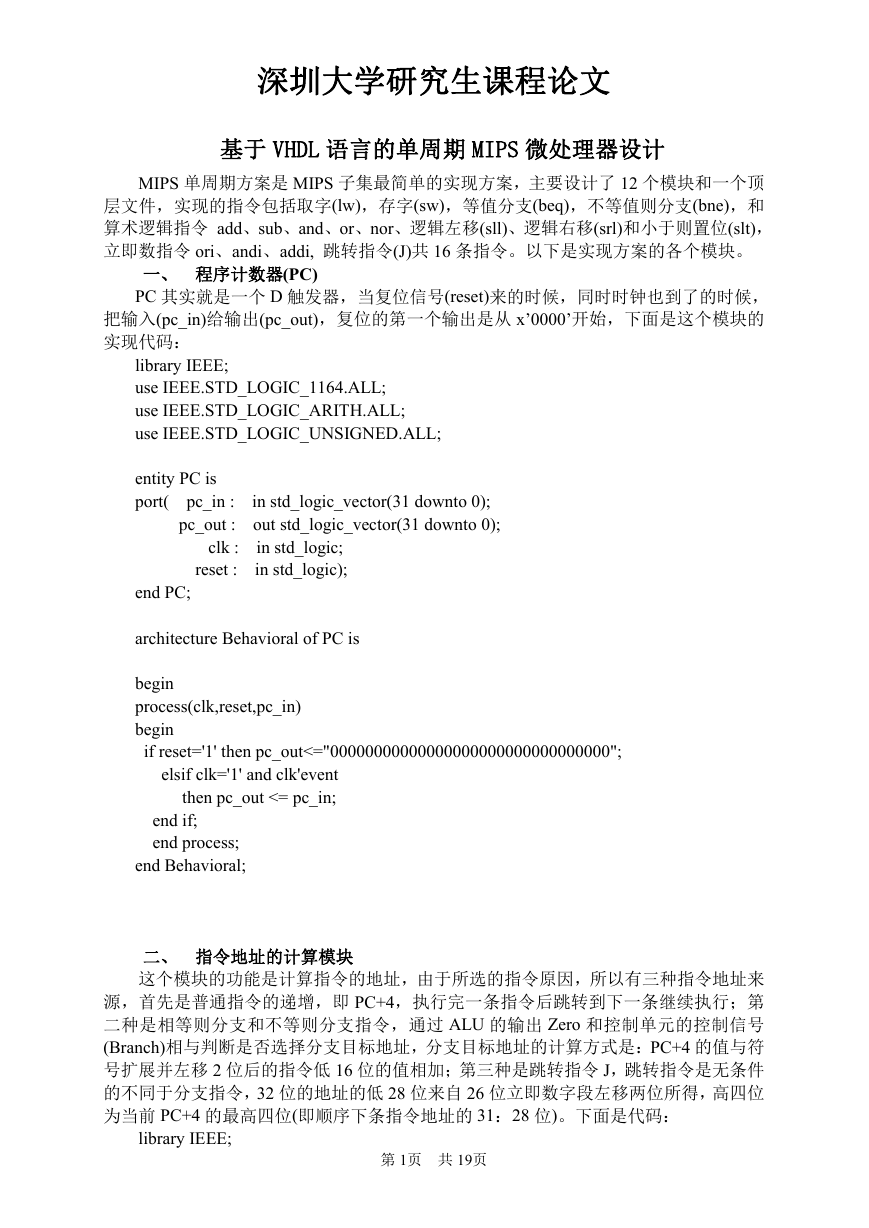
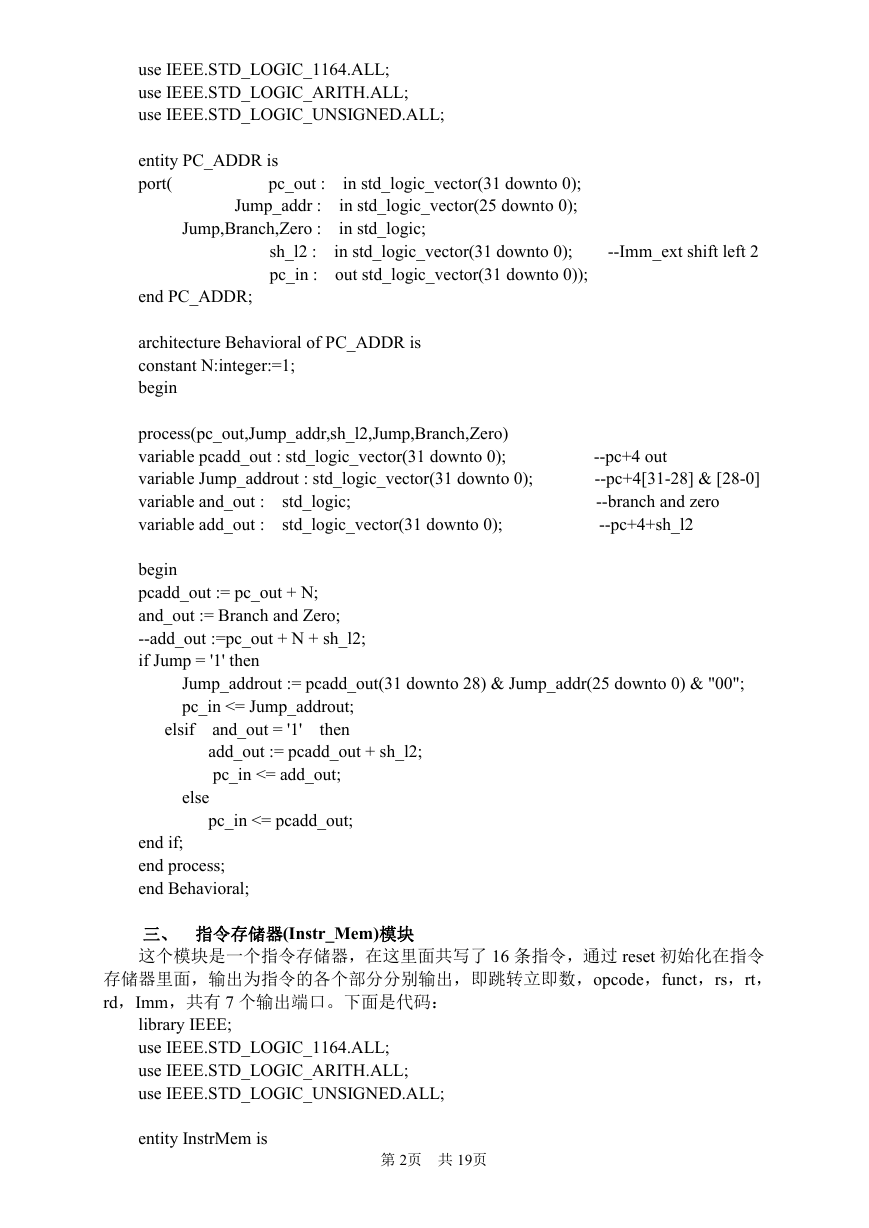
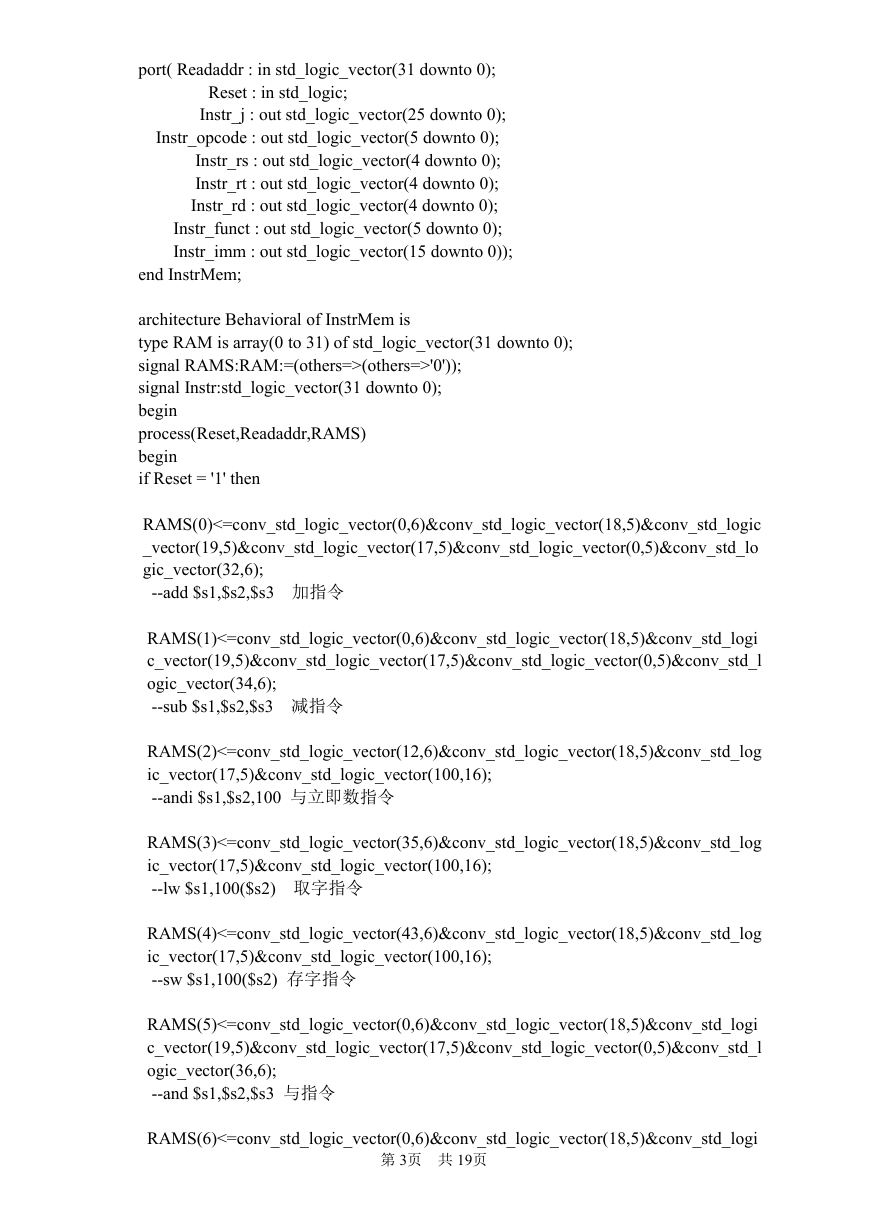
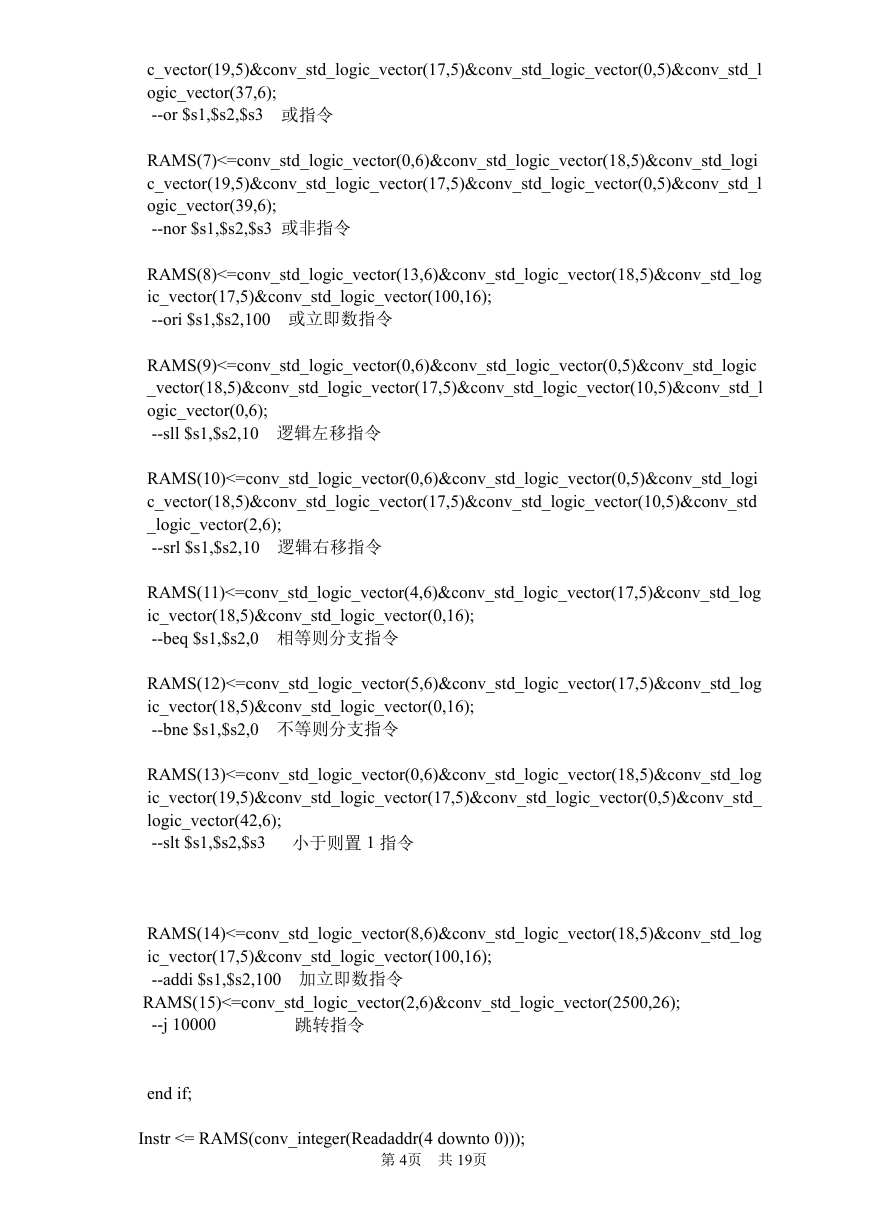
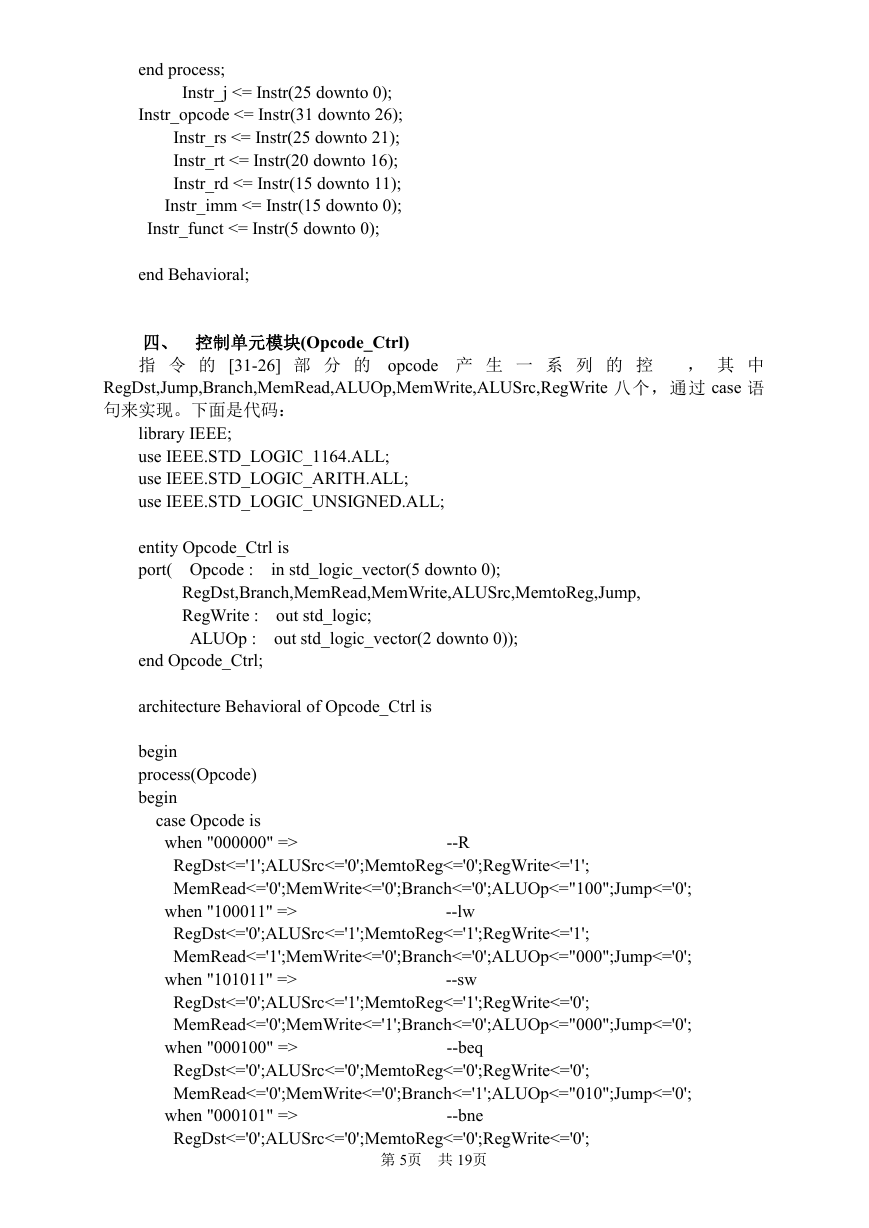
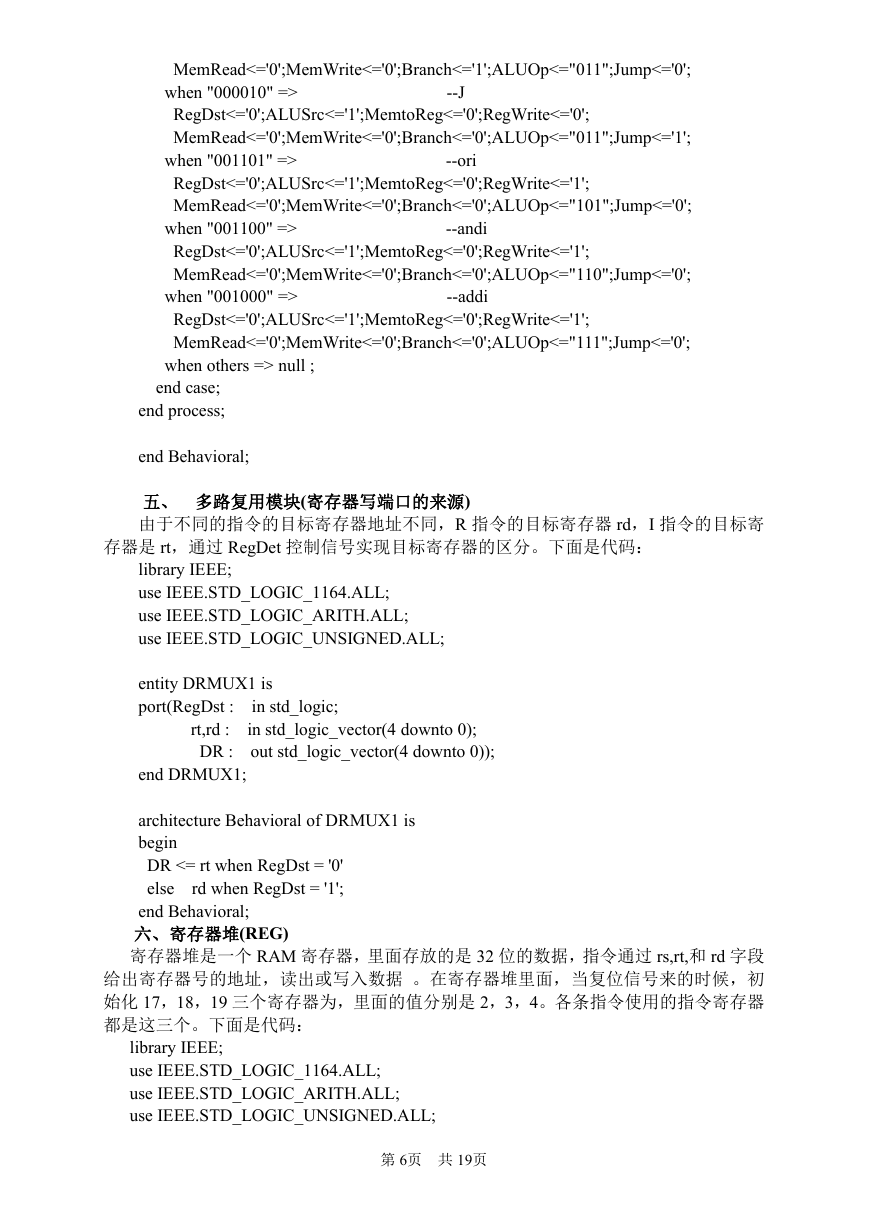
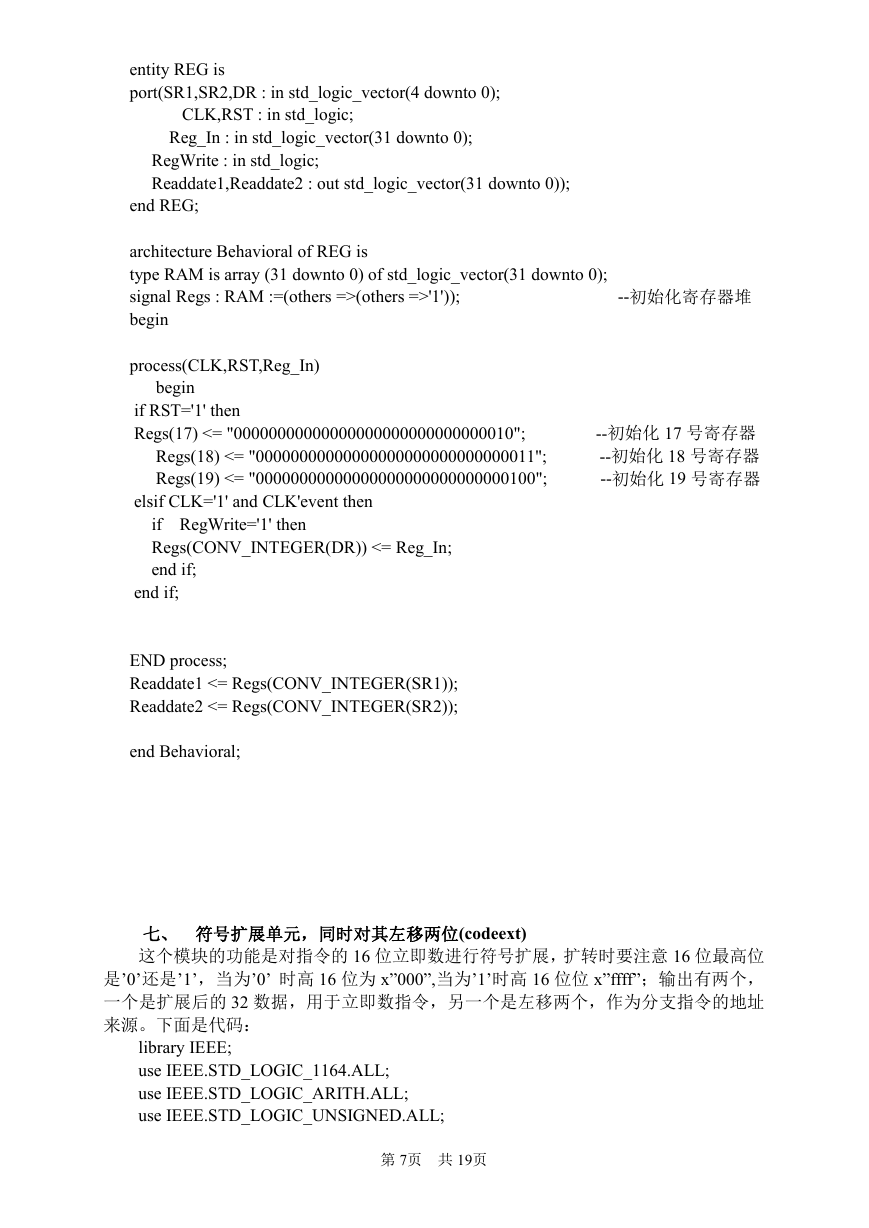









 2023年江西萍乡中考道德与法治真题及答案.doc
2023年江西萍乡中考道德与法治真题及答案.doc 2012年重庆南川中考生物真题及答案.doc
2012年重庆南川中考生物真题及答案.doc 2013年江西师范大学地理学综合及文艺理论基础考研真题.doc
2013年江西师范大学地理学综合及文艺理论基础考研真题.doc 2020年四川甘孜小升初语文真题及答案I卷.doc
2020年四川甘孜小升初语文真题及答案I卷.doc 2020年注册岩土工程师专业基础考试真题及答案.doc
2020年注册岩土工程师专业基础考试真题及答案.doc 2023-2024学年福建省厦门市九年级上学期数学月考试题及答案.doc
2023-2024学年福建省厦门市九年级上学期数学月考试题及答案.doc 2021-2022学年辽宁省沈阳市大东区九年级上学期语文期末试题及答案.doc
2021-2022学年辽宁省沈阳市大东区九年级上学期语文期末试题及答案.doc 2022-2023学年北京东城区初三第一学期物理期末试卷及答案.doc
2022-2023学年北京东城区初三第一学期物理期末试卷及答案.doc 2018上半年江西教师资格初中地理学科知识与教学能力真题及答案.doc
2018上半年江西教师资格初中地理学科知识与教学能力真题及答案.doc 2012年河北国家公务员申论考试真题及答案-省级.doc
2012年河北国家公务员申论考试真题及答案-省级.doc 2020-2021学年江苏省扬州市江都区邵樊片九年级上学期数学第一次质量检测试题及答案.doc
2020-2021学年江苏省扬州市江都区邵樊片九年级上学期数学第一次质量检测试题及答案.doc 2022下半年黑龙江教师资格证中学综合素质真题及答案.doc
2022下半年黑龙江教师资格证中学综合素质真题及答案.doc